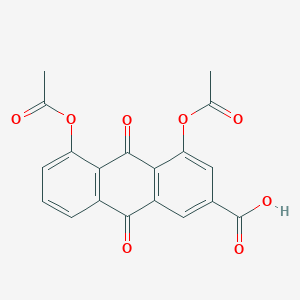-
Categories
-
Pharmaceutical Intermediates
-
Active Pharmaceutical Ingredients
-
Food Additives
- Industrial Coatings
- Agrochemicals
- Dyes and Pigments
- Surfactant
- Flavors and Fragrances
- Chemical Reagents
- Catalyst and Auxiliary
- Natural Products
- Inorganic Chemistry
-
Organic Chemistry
-
Biochemical Engineering
- Analytical Chemistry
- Cosmetic Ingredient
-
Pharmaceutical Intermediates
Promotion
ECHEMI Mall
Wholesale
Weekly Price
Exhibition
News
-
Trade Service
Editor’s note iNature is China’s largest academic official account.
It is jointly created by a team of doctors from Tsinghua University, Harvard University, Chinese Academy of Sciences and other units.
The iNature Talent Official Account is now launched, focusing on talent recruitment, academic progress, and scientific research information.
Those who are interested can Long press or scan the QR code below to follow us
.
iNature's regulatory T lymphocyte (Treg) homing response mediated by G protein-coupled receptor (GPCR)-ligand interaction plays a core role in maintaining intestinal immune homeostasis by suppressing inappropriate immune responses in the gastrointestinal tract Role
.
However, the origin of Treg homing to the large intestine remains a mystery
.
On December 23, 2021, Professor Deng Cheng’s team published a study titled "GPR15-C10ORF99 functional pairing initiates colonic Treg homing in amniotes" on EMBO Reports (IF=8.
81).
The study clarified the C10ORF99 peptide (also known as CPR15L).
And AP57) are the homologous ligands of GPR15, originated from the duplication of the flanking CDHR1 gene, and functionally pair with GPR15 in amniotic animals and control the homing of Treg to the large intestine
.
Evolutionary analysis and experimental data show that GPR15-C10ORF99 pairing is functionally conserved and mediates the homing of large intestinal Tregs of amniotic animals, and their expression patterns are positively correlated with the diet of herbivores in the large intestine
.
With the emergence of herbivorous diet in early amniotic animals, a new biological process was formed (short-chain fatty acid-C10ORF99/GPR15 induced Treg homeostasis in the colonic immune homeostasis).
This study proposed an evolutionary model, namely GPR15- The C10ORF99 functional pairing initiated the first large intestinal Treg homing response in amniotic animals
.
The results of this study also emphasized that GPCR-ligand pairing led to physiological adaptations in vertebrate evolution
.
The activation and differentiation of T cells occur in the lymph nodes, and the activated T cells need to undergo chemotaxis to perform their functions in specific tissues
.
Previous studies have confirmed that a type of chemokine receptors are expressed on the surface of T cells, most of which are G Protein-Coupled Receptors (GPCRs), which migrate to the vicinity of the tissue under the stimulation of corresponding ligands.
Nest) and stabilize it through the interaction of adhesion molecules on the surface of T cells and the surface of epidermal cells
.
GPR15 is believed to be involved in regulating the homing of colorectal Treg cells.
It mainly mediates the recruitment of Treg cells by interacting with the colorectal epithelial cells specifically expressing ligand C10ORF99, and plays an important role in maintaining intestinal immune homeostasis
.
Compared with small intestine Treg cell homing and its functional receptor ligand CCR9-CCL25 is conserved in vertebrates, the large intestine is only present in quadrupeds but does not exist in fish, so the large intestine Treg cell homing function The origin is not clear
.
At the same time, when the functional pairing of the homing receptor ligands C10ORF99 and GPR15 of large intestine Treg cells originated, what kind of biological functions and regulatory mechanisms have yet to be studied
.
Based on this scientific question, Professor Deng Cheng’s team thoroughly explored the origin of colonic Treg cell homing and the role and mechanism of GPR15-C10ORF99 functional pairing
.
The study found through molecular evolution analysis that the GPR15 receptor belongs to the Apelin/angiotensin/bradykinin family, originated from vertebrates, but is lost in most fish and amphibians, is fixed in amniotic animals and is highly conserved
.
At the same time, we found that the ligand C10ORF99 sequence originated from the duplication of the C10ORF99 flanking gene CDHR1 in amniotic animals, and was specifically expressed in the large intestine of amniotic animals, and its mature peptide was highly conserved
.
It was confirmed by in vitro experiments that GPR15 in some fishes was subjected to different selective pressures from amniotic animals and could not bind to the ligand C10ORF99.
Starting from amniotic animals, C10ORF99 paired with GPR15 for the first time and was functionally conserved
.
Further in vivo studies have found that GPR15-C10ORF99 has a large intestinal Treg homing function in amniotic animals.
Vegetarian diet can produce a large amount of SCFAs (short-chain fatty acids) to promote the expression of GPR15-C10ORF99 and promote the homing of Treg cells.
Its expression pattern is similar to that of the large intestine.
Chinese vegetarian diet is positively correlated
.
This separates the homing function of large intestine Treg from the small intestine, and the functional pairing of GPR15-C10ORF99 plays an important role in the homing process of specific large intestine Treg
.
The article model diagram (picture from EMBO Reports) This study clarified for the first time a new biological process that regulates colon immune homeostasis through vegetarian-short-chain fatty acid-C10ORF99/GPR15-Treg, and proposed the function of GPR15-C10ORF99 Pairing is the first evolutionary model that participates in colonic Treg homing in amniotic animals, and it is also of great significance to understand that GPCR receptor-ligand pairing affects the physiological adaptation process in vertebrate evolution
.
The work was mainly completed by master student Song Jingjing and postdoctoral fellow Zheng Huaping, postdoctoral fellow Sun Qian, doctoral students Liu Jian, Liu Fang, and master's students Xue Jingwen, Yang Wei and Xiang Xiangying as the main participants, co-professor-Professor Cheng Jingqiu of Sichuan University, Juergen Professor Brosius, Professor Li Wei, Associate Professor Chen Younan, Professor Jin Jin from Zhejiang University, Professor Kai He from Southern Medical University are the co-authors, and Professor Deng Cheng is the corresponding author of this article
.
Reference message: https://
It is jointly created by a team of doctors from Tsinghua University, Harvard University, Chinese Academy of Sciences and other units.
The iNature Talent Official Account is now launched, focusing on talent recruitment, academic progress, and scientific research information.
Those who are interested can Long press or scan the QR code below to follow us
.
iNature's regulatory T lymphocyte (Treg) homing response mediated by G protein-coupled receptor (GPCR)-ligand interaction plays a core role in maintaining intestinal immune homeostasis by suppressing inappropriate immune responses in the gastrointestinal tract Role
.
However, the origin of Treg homing to the large intestine remains a mystery
.
On December 23, 2021, Professor Deng Cheng’s team published a study titled "GPR15-C10ORF99 functional pairing initiates colonic Treg homing in amniotes" on EMBO Reports (IF=8.
81).
The study clarified the C10ORF99 peptide (also known as CPR15L).
And AP57) are the homologous ligands of GPR15, originated from the duplication of the flanking CDHR1 gene, and functionally pair with GPR15 in amniotic animals and control the homing of Treg to the large intestine
.
Evolutionary analysis and experimental data show that GPR15-C10ORF99 pairing is functionally conserved and mediates the homing of large intestinal Tregs of amniotic animals, and their expression patterns are positively correlated with the diet of herbivores in the large intestine
.
With the emergence of herbivorous diet in early amniotic animals, a new biological process was formed (short-chain fatty acid-C10ORF99/GPR15 induced Treg homeostasis in the colonic immune homeostasis).
This study proposed an evolutionary model, namely GPR15- The C10ORF99 functional pairing initiated the first large intestinal Treg homing response in amniotic animals
.
The results of this study also emphasized that GPCR-ligand pairing led to physiological adaptations in vertebrate evolution
.
The activation and differentiation of T cells occur in the lymph nodes, and the activated T cells need to undergo chemotaxis to perform their functions in specific tissues
.
Previous studies have confirmed that a type of chemokine receptors are expressed on the surface of T cells, most of which are G Protein-Coupled Receptors (GPCRs), which migrate to the vicinity of the tissue under the stimulation of corresponding ligands.
Nest) and stabilize it through the interaction of adhesion molecules on the surface of T cells and the surface of epidermal cells
.
GPR15 is believed to be involved in regulating the homing of colorectal Treg cells.
It mainly mediates the recruitment of Treg cells by interacting with the colorectal epithelial cells specifically expressing ligand C10ORF99, and plays an important role in maintaining intestinal immune homeostasis
.
Compared with small intestine Treg cell homing and its functional receptor ligand CCR9-CCL25 is conserved in vertebrates, the large intestine is only present in quadrupeds but does not exist in fish, so the large intestine Treg cell homing function The origin is not clear
.
At the same time, when the functional pairing of the homing receptor ligands C10ORF99 and GPR15 of large intestine Treg cells originated, what kind of biological functions and regulatory mechanisms have yet to be studied
.
Based on this scientific question, Professor Deng Cheng’s team thoroughly explored the origin of colonic Treg cell homing and the role and mechanism of GPR15-C10ORF99 functional pairing
.
The study found through molecular evolution analysis that the GPR15 receptor belongs to the Apelin/angiotensin/bradykinin family, originated from vertebrates, but is lost in most fish and amphibians, is fixed in amniotic animals and is highly conserved
.
At the same time, we found that the ligand C10ORF99 sequence originated from the duplication of the C10ORF99 flanking gene CDHR1 in amniotic animals, and was specifically expressed in the large intestine of amniotic animals, and its mature peptide was highly conserved
.
It was confirmed by in vitro experiments that GPR15 in some fishes was subjected to different selective pressures from amniotic animals and could not bind to the ligand C10ORF99.
Starting from amniotic animals, C10ORF99 paired with GPR15 for the first time and was functionally conserved
.
Further in vivo studies have found that GPR15-C10ORF99 has a large intestinal Treg homing function in amniotic animals.
Vegetarian diet can produce a large amount of SCFAs (short-chain fatty acids) to promote the expression of GPR15-C10ORF99 and promote the homing of Treg cells.
Its expression pattern is similar to that of the large intestine.
Chinese vegetarian diet is positively correlated
.
This separates the homing function of large intestine Treg from the small intestine, and the functional pairing of GPR15-C10ORF99 plays an important role in the homing process of specific large intestine Treg
.
The article model diagram (picture from EMBO Reports) This study clarified for the first time a new biological process that regulates colon immune homeostasis through vegetarian-short-chain fatty acid-C10ORF99/GPR15-Treg, and proposed the function of GPR15-C10ORF99 Pairing is the first evolutionary model that participates in colonic Treg homing in amniotic animals, and it is also of great significance to understand that GPCR receptor-ligand pairing affects the physiological adaptation process in vertebrate evolution
.
The work was mainly completed by master student Song Jingjing and postdoctoral fellow Zheng Huaping, postdoctoral fellow Sun Qian, doctoral students Liu Jian, Liu Fang, and master's students Xue Jingwen, Yang Wei and Xiang Xiangying as the main participants, co-professor-Professor Cheng Jingqiu of Sichuan University, Juergen Professor Brosius, Professor Li Wei, Associate Professor Chen Younan, Professor Jin Jin from Zhejiang University, Professor Kai He from Southern Medical University are the co-authors, and Professor Deng Cheng is the corresponding author of this article
.
Reference message: https://







